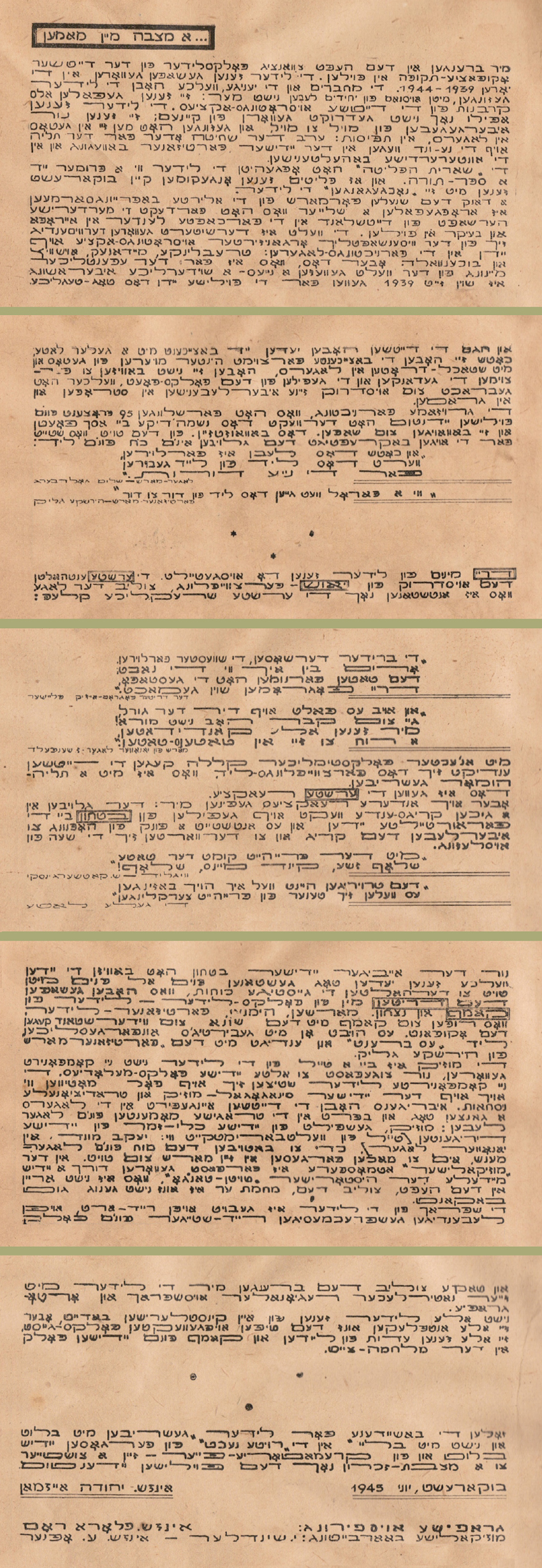BIBLIOTHECA AUGUSTANA
Mimaamakim, lider fun lagers un getos
1945
Mimaamakim,folkslider fun lagers ungetos in Poyln
1945
|
|
|
______________________________________________________________________________
|
|
|
English translation:
A gravestone for my mother
Gathered in this volume are twenty folk songs from the period of the German occupation in Poland. The songs were created between the years 1939 – 1944. The poets and the others who sang the songs are for the most part no longer living: they fell victim to the German policies of extermination. The songs were never printed but passed from mouth to mouth. And they were sung in ghettos, camps, prisons, on the eve of massacres or before the gallows, on Jewish partisan by ways, and in underground hideaways.The “surviving remnant” cherishes these songs as a pious Jew his holy books. And as the refugees arrive in Bucharest, the songs arrive with them. Thanks to the quick advance of the allied armies of liberation the veil was lifted that the murderous German ruler had cast over the captive nations of Europe, especially Poland. And although the Germans branded every Jew with a yellow patch, although they fenced them in behind walls in ghettos and barbed-wire in camps, they did not succeed in imuring the thoughts and feelings of the folk poets, who brought forth impressions of their experiences in strophes and in rhymes.The horrific annihilation, that extinquished ninety-five percent of Polish Jewry awakened the souls of many poets who began to create. This is known. The death that stood before their eyes validated faith in the strength of the song:
“And although a life was forfeit,From suffering a song was bornFor new generations to come.” – “Camp March,” Sholom Goldberg
Let this song ring out for generations to come. – “Partisan March,” Hirshke Glik
Three types of songs are presented here. The first manifests the expression of despair – desperation, due to the situation resulting from the first terrifying assault:
“The brothers shot, the sister lost,I am bereft as the night; The Gestapo has taken father away,Already, three pogroms they've made.” – “The Third Pogrom,” Itsik Flaysher
“And if this should be your fate,Then go to your grave and have no fear!We are all candidates,A curse on them in this dance of death!” – “March of Janowa Camp,” Z. Shenfeld
The song of desperation, written with gallows humor, concludes with a genuine folk-voiced curse against the Germans.That was the first response.But we find also other responses: the faith in a quick end to the war awakened feelings of confidence among the condemned Jews and it kindled a spark of hope to survive the war and await the hour of redemption.
With freedom father returnsSleep my child, sleep. – “Lullaby,” Sh. Kaczerginski
The sorrowful present I loudly proclaimwill sound forth in tones of freedom one day. – “The Yellow Patch”
Only their eternal Jewish confidence enabled Jews who everyday stood face to face with death to preserve the spiritual strength that created the third type of folksong: songs of battle and victory. Marches, hymns, partisan songs that called to fight the enemy and resist the occupier. It begin with Gebirtig's unforgettable song “Es brent” and ended with the “Partisan March” by Hirshke Glik.The music for a number of the songs was not newly composed, but fashioned from old Jewish folk melodies. The newly-composed songs also rely upon motives found in Jewish synagogal music and other traditional formulations. The remainder the Germans ordered played in the camps all day, particularly during the most tragic moments of camp life: music, played by Jewish klezmers with Jewish conductors (among them, some world-famous, such as Yakov Mund, in Janower camp), so as to becalm the minds of the camp-prisoner and make him forget that it is a march to death. In such a “musical” atmosphere, a Jewish girl created the historic “Death Tango,” which could not appear in this volume because we did not know it well enough.The language of the songs is constructed from spoken communication, from the living, voluble speech practices of the people. And on this account, we have recorded the songs with their natural regional expressions and orthography.Not every song was imbued with artistic significance, but all reveal to us the deeply awakened folk spirit. They all testify of the sorrow and struggle of the Jewish folk during wartime.May these few modest songs, “written with blood and not with lead” in the “red nights” of gushing Jewish blood and crematoria-fire, be a contribution to a memorial stone for Polish Jewry.
Bucharest, June 1945. Engineer Yehuda Ayzman.
Graphic Design: Engineer Flora Rom.Musical Arrangements: Y. Shindler; Engineer E. Opner. |
|
